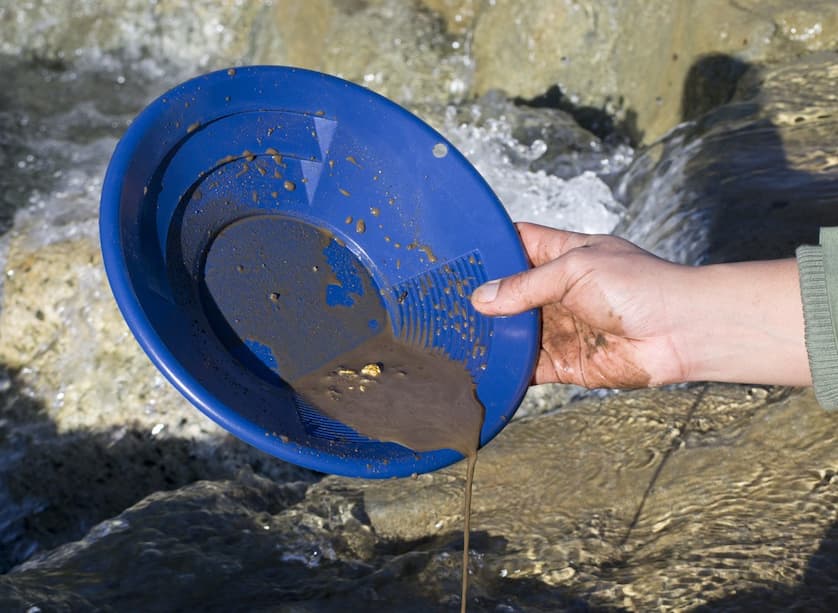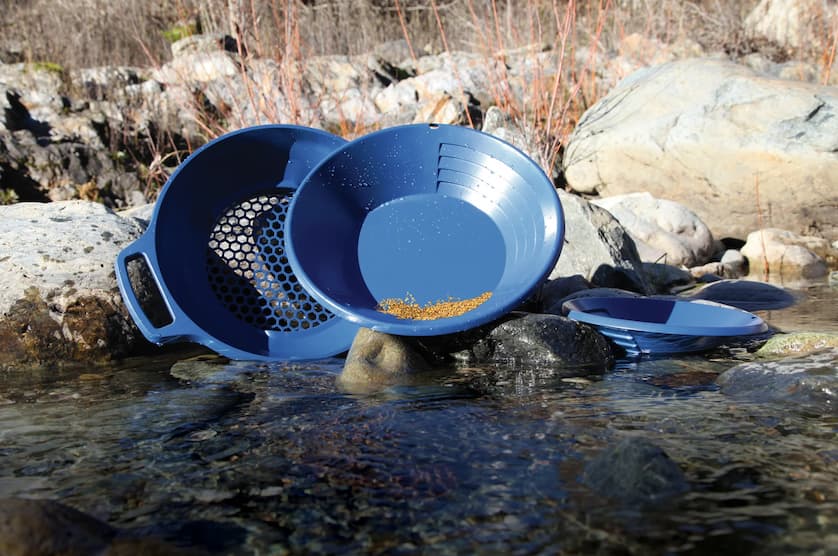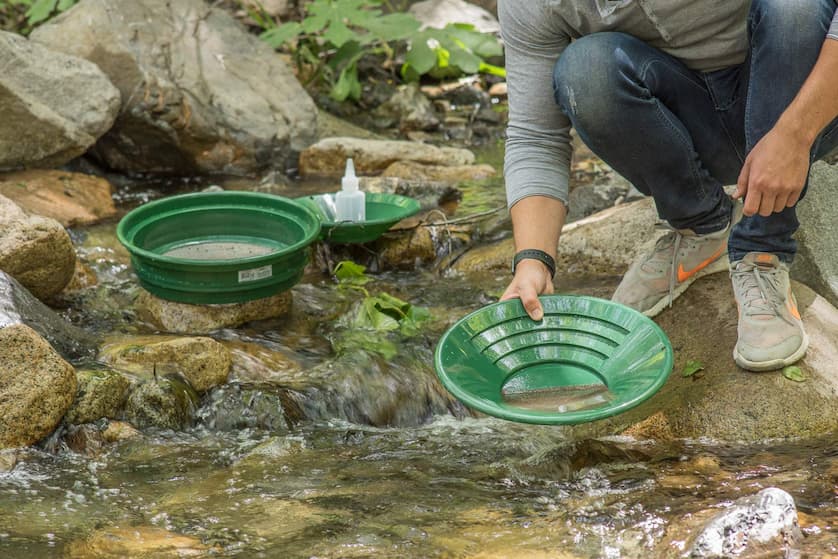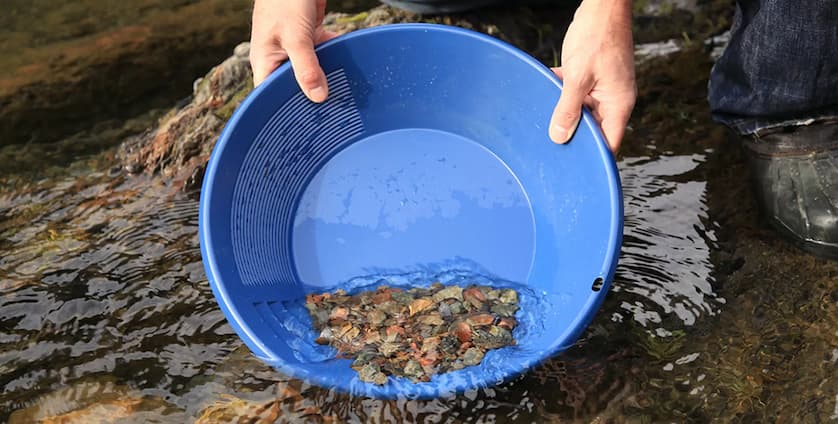Gold panning can be a very exciting and interesting activity. Many people have it as a hobby, and for others, it’s a hunting business. Wherever you belong, it’s important that you have the right equipment, besides good technique and some experience. If you’re a beginner, you may not want to invest in something expensive until you figure out if you like doing it or not. But once you establish your love for panning, you should go for the big toys and make your time worthwhile.
Contents
What to Consider When Buying
Size

This is the first thing you should consider. The pan is usually made from lightweight materials, but when it gets filled with water, rocks and hopefully gold, it’ll get heavier. That’s why you should consider the size. A lightweight and sturdy gold pan can have several sizes. Large ones come between 38-60cm in diameter. If this will be your main source of processing material, you should get this size.
The bigger the pan, the more material it can process inside of it at the same time. If you don’t intend to use other recovery methods this is a good choice. But if you’re a beginner, this might not be a good choice because it’ll be too big for your inexperienced hands. There are also standard-sized pans that are 35-40cm in diameter.
They’re designed to be the perfect blend of portability, capacity, and usability. Simply put, there is the ideal gold pan size fit for every gold panner no matter their experience and age. There are also small ones that are around 25- 30cm in diameter and they’re mostly made for kids. You could also use them to clean the gold or panning cons or concentrates.
There is a method by which you can measure which is the right size for you. Take the pan and place it against your forearm. If the widest part goes beyond your fingers, you should get a smaller one. Buying something that’s too big for you can cause muscle strain and make you very uncomfortable. This is especially important if you’re choosing a pan for kids.
Colour

A green pan is probably the first thing that comes to mind when you think about this equipment because it’s the most common one. But nowadays, these pans come in many different colours. The green one is still on top because you can easily recognise the gold sand inside. The downside is that you can easily misplace it and forget it when you’re packing to go to the next location. Green grass and a green bowl don’t go together.
Black is another option. It does a great job of showing the gold bits, but they can easily get covered by black sands. Blue pans are good for prospecting because they show both the gold and the black sands. Plus, they won’t blend with the surroundings. Pink and purple are on the rise too because they’re very bright, fun, and different.
Riffles
The riffles came with the creation of the plastic gold pans. This was a big innovation compared to the flat metal ones the gold panner used in the past. Their purpose is to trap the gold and allow the sand and rocks to get washed out. When it gets to the bottom and you swirl it, it gets trapped and won’t wash out with the things you don’t need. There are two types of riffles: large and small. They have different purposes and give you more flexibility.
Large ones are good when you’re working with pebbles and river rocks. They’ll find and catch bigger nuggets but won’t work with smaller bits. People don’t use them for panning concentrates because of this. Small riffles, on the other hand, are perfect for small flakes. They’re great when you work with sand and concentrates, and will catch that gold dust for sure.
Materials

The panning enthusiasts have divided opinions on this subject. Some of them prefer plastic and some stick to metal. Metal pans are a classic. They’re the original panning equipment but have several issues. First, metal is prone to rusting, especially when you’re dipping it in water all the time. Second, it’ll get damaged easily from the swirling of the rocks and sand, and it’s hard to see gold in damaged pans.
And finally, you might have a problem separating the gold from the metals unless you’re using a magnet. A plastic gold pan is a great choice for any panner. It’s very durable, hard to break or bend and very lightweight. It can float and, most importantly, it won’t rust because of repeated contact with water.
Other Considerations
It’s always a good idea to set a budget before going shopping online or at the store. Pick a price point you want to stick to. This will narrow down your choices and make the process a lot easier. But if you don’t have a limited budget, always get the best you can find.
Keep an eye on the brand. Make sure it’s a reliable brand that makes high-quality products. Most of them provide warranties for their products, so if anything happens to it while you’re panning, they’ll replace it or fix it without additional costs.
Always read reviews and experiences of other people. They’ll lead you to the best product you can find. And last but not least, look for equipment that’s easy to use. If you’re a beginner, you don’t want to struggle with the whole process. You’ll soon get frustrated and leave the whole thing behind.
Best Places in Australia to Strike Gold

There are many places in Australia where you can begin your panning journey. Kalgoorlie, Western Australia is one of them. It has a 127-year history, and it still keeps on giving. The best time to do it is spring and autumn. Next is the Golden Triangle in Victoria. This is a very popular area where the biggest nugget in the world was discovered in 1869.
Gympie, Queensland is easy to access and holds treasures along the creek bed, in the waterway and in mounds of shale rock. We also have Clermont, Queensland which is great if you’re a beginner. This site is newly opened and very popular. Corinna, Tasmania is a bit in the wilderness, but many prospectors found their luck in this area, so why not give it a try?











